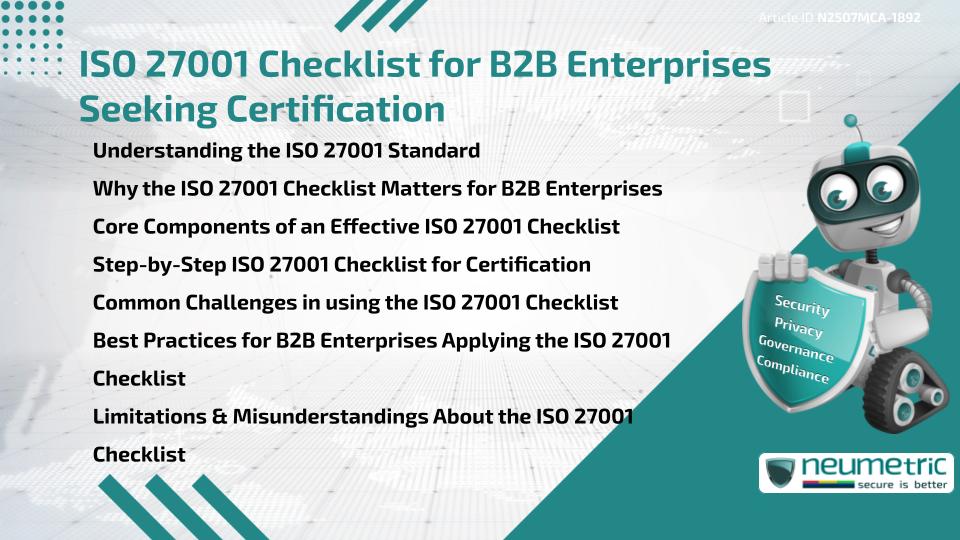Table of Contents
ToggleIntroduction
An ISO 27001 Checklist serves as a vital tool for B2B enterprises aiming to achieve Certification under the globally recognised Information Security Management System [ISMS] standard. This checklist simplifies the journey to compliance by breaking down essential requirements into actionable tasks. For B2B enterprises, adhering to an ISO 27001 Checklist not only reinforces trust with clients but also ensures structured protection of Sensitive Data. In this article, we examine what the checklist includes, how it benefits B2B organisations, key steps for implementation & common obstacles faced during certification.
Understanding the ISO 27001 Standard
ISO 27001 is an international Standard published by the International Organisation for Standardization [ISO], detailing how to manage Information Security Risks using a formal ISMS. It offers a structured methodology that includes Risk Assessment, Control selection & Continuous Improvement.
For B2B enterprises, this Standard is especially important due to increased data exchanges with multiple vendors & clients. Implementing ISO 27001 helps ensure confidentiality, integrity & availability of information across all systems & processes.
You can read more about the core elements of the ISO 27001 Framework on ISO’s official website.
Why the ISO 27001 Checklist Matters for B2B Enterprises
B2B Enterprises regularly come across complex Contractual & Regulatory Environments. An ISO 27001 Checklist ensures that no critical steps are overlooked during the preparation phase. It guides organisations through documentation, Risk analysis & Control Implementation while offering a clear structure for internal audits & external Certification assessments.
The checklist helps to:
- Avoid delays during audits
- Ensure Stakeholder alignment
- Detect compliance gaps early
- Promote consistent documentation across departments
For more context on why security frameworks matter for B2B setups, refer to this NIST overview of Risk Management.
Core Components of an Effective ISO 27001 Checklist
An ISO 27001 Checklist typically includes the following core components:
- Scoping the ISMS: Draft what all aspects of the organisation the ISMS Scope will cover.
- Leadership Commitment: Establish a Governance structure with clear responsibilities.
- Risk Assessment: Identify & evaluate Information Security Risks.
- Statement of Applicability [SoA]: Document the selected Security Controls from Annex A.
- Internal Audit Schedule: Plan & perform audits to assess compliance.
- Corrective Actions: Track & resolve gaps identified during audits or assessments.
- Documentation & Records: Maintain & manage all required Policies, procedures & evidence.
Step-by-Step ISO 27001 Checklist for Certification
Below is a streamlined checklist that B2B enterprises can follow to gain ISO 27001 Certification:
- Define Scope & Objectives
- Clarify which departments & processes fall under the ISMS.
- Secure Management Support
- Obtain leadership buy-in for time, resources & policy enforcement.
- Conduct a Risk Assessment
- Use qualitative or quantitative methods to identify key Threats.
- Develop Security Policies & Procedures
- Establish rules for Data Protection, Access Control & Business Continuity.
- Select & Implement Controls
- Pick applicable Controls from the Annex A of ISO 27001.
- Create the Statement of Applicability
- Justify inclusions & exclusions of specific Controls.
- Train & Communicate
- Educate Employees on the importance of ISMS & their roles.
- Conduct Internal Audits
- Review effectiveness of the implemented ISMS Controls.
- Address Nonconformities
- Document & fix any compliance gaps or inefficiencies.
- Engage a Certification Body
- Choose an accredited Third Party auditor to complete the formal assessment.
Refer to this UK National Cyber Security Centre guide for additional Security Controls that complement ISO 27001.
Common Challenges in using the ISO 27001 Checklist
Even with a detailed checklist, B2B enterprises may face several challenges:
- Scope Creep: Expanding the ISMS scope without adequate resources.
- Resource Allocation: Underestimating the time & personnel needed for implementation.
- Document Fatigue: Producing excessive documentation without clear value.
- Employee Engagement: Failing to build awareness or encourage participation across teams.
Awareness of these pitfalls allows for better planning & successful outcomes.
Best Practices for B2B Enterprises Applying the ISO 27001 Checklist
To ensure successful use of the checklist:
- Assign a Dedicated ISMS Manager: Accountability ensures momentum.
- Use Project Management Tools: Track checklist completion, tasks & dependencies.
- Integrate With Existing Frameworks: Align ISO 27001 with other standards like SOC 2 or HIPAA.
- Review Regularly: Periodically revisit the checklist even after certification.
- Involve Stakeholders Early: Include representatives from legal, HR, operations & IT.
Explore this Cyber Essentials checklist for a simpler starting point for small or medium B2B firms.
Limitations & Misunderstandings About the ISO 27001 Checklist
Despite its usefulness, an ISO 27001 Checklist has limitations:
- Not a Substitute for Expertise: The checklist guides but doesn’t replace deep knowledge of ISO 27001.
- Over-Simplification: Some tasks might appear complete when in fact more thorough implementation is needed.
- One-Size-Fits-All Pitfall: A generic checklist may not fully address industry-specific Risks.
It is important to supplement checklists with Expert Consultation & tailored Risk Assessments.
Takeaways
- An ISO 27001 Checklist offers a structured path for B2B enterprises working towards certification.
- It helps simplify complex Compliance Requirements into manageable steps.
- Businesses must adapt the checklist to their specific industry & internal structure.
- Regular reviews & cross-functional collaboration are essential for success.
- A checklist is a guide, not a guarantee-expert guidance remains essential.
FAQ
What is the ISO 27001 Checklist?
It is a structured list of tasks & documents needed to implement an ISMS & prepare for ISO 27001 Certification.
Who should use the ISO 27001 Checklist?
IT managers, compliance officers & security leads in B2B enterprises preparing for ISO 27001 Certification.
Is the ISO 27001 Checklist mandatory?
No, but it is a highly recommended tool to ensure nothing critical is missed during preparation.
Duration to complete the ISO 27001 Checklist?
Depending on company size & maturity, it can take from three (3) to twelve (12) months.
What is included in an ISO 27001 Checklist?
Scope definition, Risk Assessment, Control selection, SoA, documentation & Internal Audit planning.
Can the ISO 27001 Checklist be used by small B2B businesses?
Yes, but they should tailor it to their specific scale & Risk profile.
Do Auditors require the ISO 27001 Checklist?
Auditors do not require it, but using one helps demonstrate preparedness & thoroughness.
How often should the ISO 27001 Checklist be reviewed?
At least annually or after significant changes to Business Operations or information systems.
References
- https://www.iso.org/isoiec-27001-information-security.html
- https://csrc.nist.gov/publications/detail/sp/800-37/rev-2/final
- https://www.ncsc.gov.uk/collection/10-steps
- https://www.ncsc.gov.uk/cyberessentials/overview
Need help for Security, Privacy, Governance & VAPT?
Neumetric provides organisations the necessary help to achieve their Cybersecurity, Compliance, Governance, Privacy, Certifications & Pentesting needs.
Organisations & Businesses, specifically those which provide SaaS & AI Solutions in the Fintech, BFSI & other regulated sectors, usually need a Cybersecurity Partner for meeting & maintaining the ongoing Security & Privacy needs & requirements of their Enterprise Clients & Privacy conscious Customers.
SOC 2, ISO 27001, ISO 42001, NIST, HIPAA, HECVAT, EU GDPR are some of the Frameworks that are served by Fusion – a SaaS, multimodular, multitenant, centralised, automated, Cybersecurity & Compliance Management system.
Neumetric also provides Expert Services for technical security which covers VAPT for Web Applications, APIs, iOS & Android Mobile Apps, Security Testing for AWS & other Cloud Environments & Cloud Infrastructure & other similar scopes.
Reach out to us by Email or filling out the Contact Form…


